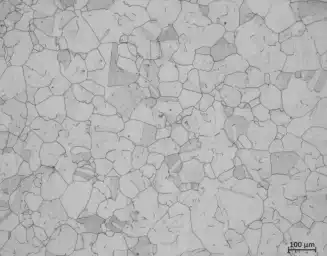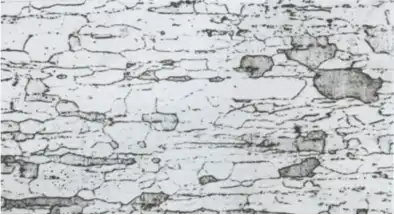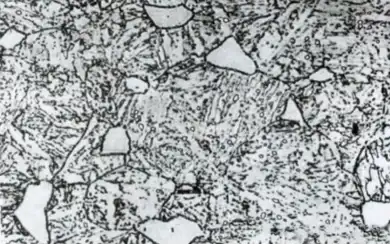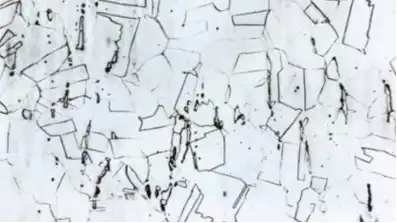
Knowledge
The Characteristics of Five Types of Stainless Steel (Austenitic, Ferritic, Martensitic, Duplex and Precipitation-hardening)
Austenitic stainless steel

Austenitic stainless steel has a main body of austenitic structure (γ phase) with a face-centered cubic (fcc) lattice. Common types include 304, 316, etc. It is non-magnetic and is mainly strengthened through cold working.
Its mechanical properties cannot be altered by heat treatment methods; only cold deformation can be used for strengthening.
Non-magnetism, excellent low-temperature performance, good formability and weldability are the important characteristics of this type of steel.
Ferritic stainless steel

Ferritic stainless steel is a type of stainless steel that mainly consists of ferrite structure in its service condition. Common types include 405 and 430, etc. It has superior resistance to stress corrosion cracking compared to austenitic stainless steel series; it exhibits strong magnetism at room temperature; it cannot be hardened by heat treatment and has excellent cold workability.
Due to the stable presence of ferrite phase, quenching cannot harden ferritic stainless steel. It can achieve the highest ductility and corrosion resistance in the annealed state. It is magnetic at room temperature. This type of steel has the characteristics of high thermal conductivity, small expansion coefficient, good oxidation resistance, and excellent resistance to stress corrosion. It is often used to manufacture parts that resist corrosion from the atmosphere, water vapor, water, and oxidizing acids. However, it has disadvantages such as poor plasticity and significant reduction in plasticity and corrosion resistance after welding, which limits its application. It is mostly used for interior decoration in buildings, components of heavy oil burners, household utensils, and parts of household appliances.
Martensitic stainless steel (M)

Martensitic stainless steel refers to the steel with a martensitic structure as the matrix, such as 403, 416, 420, 440, etc. The main characteristics of martensitic stainless steel are that it is strongly magnetic at room temperature. Its corrosion resistance is not particularly outstanding, but it has high strength and is often used as high-strength structural steel.
It has a strong tendency to harden, and is prone to cold cracking. In the welding joint, the area heated above 1150℃ will have significantly enlarged grains. Both too fast and too slow cooling rates may cause joint embrittlement, and it is also prone to 475℃ embrittlement. Its susceptibility to intergranular corrosion is relatively low. 30Cr13, 40Cr13, 40Cr17Mo, and 95Cr18 have a stronger hardening tendency and generally cannot be welded. Martensitic stainless steel has a distinct phase transition point and can be strengthened through quenching. With a high chromium content and good hardenability, its hardness, strength and toughness can be adjusted over a wide range during tempering. High-carbon martensitic stainless steel has a high hardness and can thus be used as both structural steel and tool steel. It is generally applied to components such as shafts, piston rods, pumps, valves, which require high mechanical properties, high hardenability, and resistance to nitric acid and organic acid corrosion, as well as for springs and fasteners.
Duplex stainless steel

Duplex stainless steel refers to stainless steel in which ferrite and austenite each account for approximately 50%, and the content of the less phase should be at least 30%. This type of steel combines the characteristics of both austenitic and ferritic stainless steels. Common examples include 2205.
Compared with ferritic steel, it has higher plasticity and toughness, no room-temperature brittleness, significantly improved resistance to intergranular corrosion and welding performance, while still maintaining the 475°C brittleness and high thermal conductivity of ferritic stainless steel, as well as superplasticity and other features.
Compared with austenitic stainless steel, it has higher strength and significantly improved resistance to intergranular corrosion and chloride stress corrosion.
Molybdenum-containing duplex stainless steel has excellent resistance to chloride stress corrosion at low stress, as well as good resistance to corrosion fatigue and wear corrosion. Under certain corrosive medium conditions, it is suitable for manufacturing power equipment such as pumps and valves.
It has excellent comprehensive mechanical properties, with high strength and fatigue strength. It has good weldability and a low tendency to hot cracking. Generally, preheating is not required before welding, and post-weld heat treatment is not necessary. Compared with austenitic stainless steel, it has a higher thermal conductivity and a lower coefficient of linear expansion, making it suitable for use as a lining in equipment and for producing composite plates. It is also suitable for manufacturing the cores of heat exchangers, and its heat exchange efficiency is higher than that of austenitic stainless steel. It is not suitable for use in conditions above 300℃. Duplex stainless steel can be used in the fields of oil refining, fertilizers, papermaking, petroleum, and chemical engineering for heat exchangers, condensers, and components that are resistant to seawater, high temperatures, and concentrated nitric acid.
Precipitation hardening stainless steel

Precipitation-hardened stainless steel is a type of stainless steel with a matrix of austenite or martensite, which is hardened (strengthened) through precipitation hardening (also known as aging hardening). Common examples include 630 and 660, etc. Precipitation-hardened stainless steel combines the characteristics of these types of steel, featuring both the corrosion resistance of austenitic stainless steel and the high strength of martensitic stainless steel.
Precipitation-hardening stainless steel combines the advantages of high strength and good corrosion resistance. Its corrosion resistance is not only related to the chemical composition but also to the heat treatment, especially closely related to the aging temperature.
Precipitation-hardening stainless steel belongs to high-strength stainless steel. In industrial applications, special attention should be paid to hydrogen cracking and stress corrosion cracking.
It is widely used in components that require both high strength and high corrosion resistance and oxidation resistance, such as low-pressure turbine shafts, guide vanes, working vanes, fan frames, combustion chamber parts of aero engines, as well as in petrochemical, shipbuilding, nuclear reactors, steam turbines, high-strength forgings, and valve parts of high-pressure systems.
Vigor has rich experience in producing high-quality castings and Forgings. If you have any questions, demands, new parts need to be developed or improve your supply chain, please feel free to contact us info@castings-forging.com



